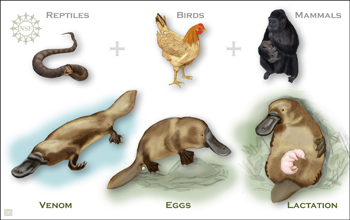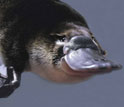News Release 08-076
Platypus Genome Decoded
Genome may yield clues about evolution and disease prevention

Platypus DNA is a combination of reptiles, birds and mammals.
May 7, 2008
This material is available primarily for archival purposes. Telephone numbers or other contact information may be out of date; please see current contact information at media contacts.
The curious discovery of the duck-billed, egg-laying, otter-footed, beaver-tailed, venomous platypus in Australia in 1798 convinced British scientists that it must be a hoax. Sketches of its appearance were thought to be impossible.
But new research proves that the oddness of the platypus' looks isn't just skin-deep. Platypus DNA is an equally cobbled-together array of avian, reptilian and mammalian lineages that may hold clues for human disease prevention.
Mark Batzer of Louisiana State University, along with an international group of scientists led by Wes Warren at Washington University in St. Louis, Mo., recently completed the first draft sequence and analysis of the platypus genome.
It was the first genome sequencing project of a mammal that lays eggs, confirming that platypus DNA also looks like something of a patchwork.
"Their genomic organization was strange and a little unexpected," says Batzer. "It appeared much more bird- and reptile-like than mammalian, even though it is indeed classified as a mammal."
Having the genome in hand is a huge step for scientists seeking new details about evolution and human disease. The fact that the platypus is an ancient animal that is relatively primitive and unchanged may be a scientific boon for researchers.
At least that's the hope of researchers at the National Science Foundation (NSF), who partially funded the study. "Looking at the platypus genome may yield clues about the functions of certain components of DNA and contribute to our understanding of evolution," says Mark Weiss, division director for NSF's behavioral and cognitive sciences.
The platypus occupies the first branch of the mammalian tree of life after the split from "sauropsids" about 315 million years ago. It maintains some long dated features and, as a result, should provide information on how mammals evolved.
"DNA contains small 'mobile elements' that make copies of themselves and then are inserted elsewhere into the genome. These elements can influence important evolutionary processes, and we want to know more about them," says Weiss.
"These mobile elements were once thought to be so small that they had no function," says Batzer. "But, in reality, they cause insertions and deletions which can lead to genetic diseases in humans and they are also involved in the creation of new genes and gene families."
Grants from the National Institutes of Health focused on aspects of genetic disease.
"This is a huge genetic step. We're learning a lot about mammalian gene regulation and immune systems, which has huge implications for disease susceptibility research," says Batzer. "We hope to, in time, identify the underlying causes and methods of disease prevention in humans."
Better insight into monotreme biology, or the biology of mammals that lay eggs, provides a "baseline" for understanding immunity, reproduction and chemoreception, which can further the study of the evolution of human biology.
"In other words, it provides the ‘big picture' as compared to the genomes of other animals more similar to humans that have a more focused window," says Batzer.
In addition, the platypus was chosen as the subject of this study in large part due to its strange appearance, but other selection factors include the species' endangered status in its only indigenous habitat, Australia.
One interesting finding for the researchers is that several of the populations seem to have been geographically separated for a long time. Based on an analysis using mobile elements, the population on the island of Tasmania seemed genetically far distanced compared to other platypus populations from the mainland of Australia.
This was one of the largest platypus population genetics studies ever conducted.
Platypuses are extremely shy by nature and only a few places like Healesville Sanctuary in Victoria, Australia, have had success breeding them in captivity. Researchers hope that some of the clues unearthed in the platypus genome might lead to a better understanding of the history of the species and new conservation efforts.
-NSF-
-
View Video
Mark Batzer of LSU explains the curious makeup of platypus DNA.
Credit and Larger Version -
The otter-footed platypus is comfortable on both land and in water.
Credit and Larger Version -
Platypus research may help uncover information about human gene regulation and immune systems.
Credit and Larger Version
Media Contacts
Bobbie Mixon, NSF, (703) 292-8485, email: bmixon@nsf.gov
Lisa-Joy Zgorski, NSF, (703) 292-8311, email: lzgorski@nsf.gov
Ashley Berthelot, Louisiana State University, (225) 578-3870, email: aberth4@lsu.edu
Program Contacts
Mark Weiss, NSF, (703) 292-7272, email: mweiss@nsf.gov
Co-Investigators
Mark Batzer, Louisiana State University, (225) 578-7102, email: mbatzer@lsu.edu
Related Websites
Healesville Sanctuary, Victoria, Australia: http://www.zoo.org.au/HealesvilleSanctuary
The U.S. National Science Foundation propels the nation forward by advancing fundamental research in all fields of science and engineering. NSF supports research and people by providing facilities, instruments and funding to support their ingenuity and sustain the U.S. as a global leader in research and innovation. With a fiscal year 2023 budget of $9.5 billion, NSF funds reach all 50 states through grants to nearly 2,000 colleges, universities and institutions. Each year, NSF receives more than 40,000 competitive proposals and makes about 11,000 new awards. Those awards include support for cooperative research with industry, Arctic and Antarctic research and operations, and U.S. participation in international scientific efforts.
Connect with us online
NSF website: nsf.gov
NSF News: nsf.gov/news
For News Media: nsf.gov/news/newsroom
Statistics: nsf.gov/statistics/
Awards database: nsf.gov/awardsearch/
Follow us on social
Twitter: twitter.com/NSF
Facebook: facebook.com/US.NSF
Instagram: instagram.com/nsfgov





